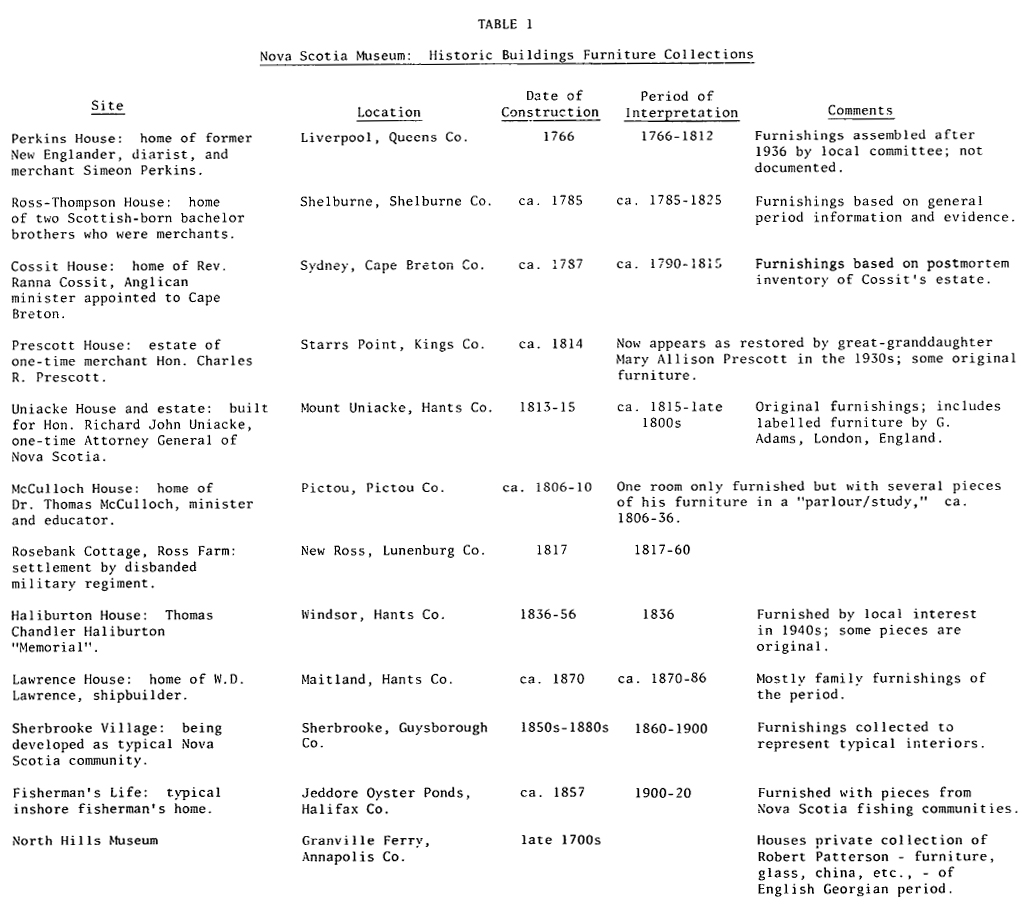Furniture in Public Collections in Canada / La Collection Nationale de Mobilier
Nova Scotia Museum Furniture Collections
Several major Canadian institutions were invited to describe their furniture collections for this thematic issue. The reports received are published below.
Les co-rédacteurs ont demandé à plusieurs institutions canadiennes importantes de leur faire parvenir des descriptions de leurs collections de mobilier. Vous trouverez, ci-après, des comptes rendus reçus.
Nature of the Collections
1 The Nova Scotia Museum's history collections are dispersed throughout the province at twenty branch museums, sixteen of which are historic buildings and sites. The furniture collection contains furniture made or used in Nova Scotia and spans the period ca. 1750-1980 although most of the pieces predate 1900. The collection divides broadly into two groups — the historic buildings collections which are used in furnishing each building or site and the provincial collection (all other furniture).
2 Both collections include furniture marked by or attributed to particular makers. There are traditional furniture forms in native woods and of local manufacture, including a number of rod-back Windsor chairs by known makers. There is also designer-influenced furniture in both native and imported woods. This latter category includes eighteenth- and early nineteenth-century furniture made in Nova Scotia, Great Britain, and New England, a few French pieces, and late nineteenth-century, factory-made pieces from Nova Scotia and elsewhere.
3 Twelve of the museum sites either are or include domestic buildings, representing six generations of Nova Scotia life and a range of social and economic situations. Some are furnished to a particular period; in others the history of occupancy is chronicled by a greater diversity in the furnishings (see table 1 following).
Formation of the Collections
4 The Provincial Museum of Nova Scotia was established as such in 1868 but the furniture collection did not begin until about ninety years later with the appointment of George MacLaren as curator of the history collections. MacLaren was interested in studying what had been made in Nova Scotia and several of the pieces illustrated in his Antique Furniture by Nova Scotia Craftsmen (Toronto: Ryerson Press, 1961) are those collected by him.
5 During the late 1930s and early 1940s two Nova Scotian houses had been furnished as "historic houses" by local historical societies. These two sites, Perkins House in Liverpool and Haliburton House in Windsor, subsequently became part of the Nova Scotia Museum. They reflect the 1930s concern for a general period effect rather than for accuracy. A greater regard for documentation has been evident in furnishing the sites which have been added to the Nova Scotia Museum during the last decade. Although the final product still must often be an estimate, it is an estimate based upon journals, inventories, land records, advertisements, and other Nova Scotian sources.
Research on the Collections
6 A significant element in the historic buildings furniture collection is the unique group of labelled pieces by the London cabinetmaker George Adams, ca. 1790-1822 (see figs. 1 and 2). Very few furniture makers in England identified their work so that labelled furniture of English manufacture is rare. Research is underway to learn more about George Adams using documentary material at the Victoria and Albert Museum.
7 Reed and rattan furniture was produced in Nova Scotia by several manufacturers. Those of specific interest include the Windsor Furniture Company, Windsor Rattan Company, and J.E. Smith and Company, all of Windsor, Hants County. Labelled pieces are being added to the collection and a study is in progress on the ways in which reed and rattan have been used.
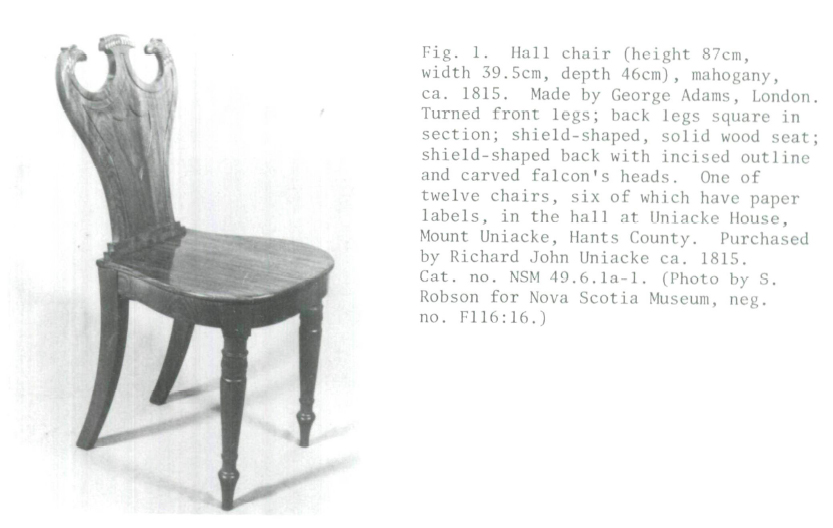 Display large image of Figure 1
Display large image of Figure 1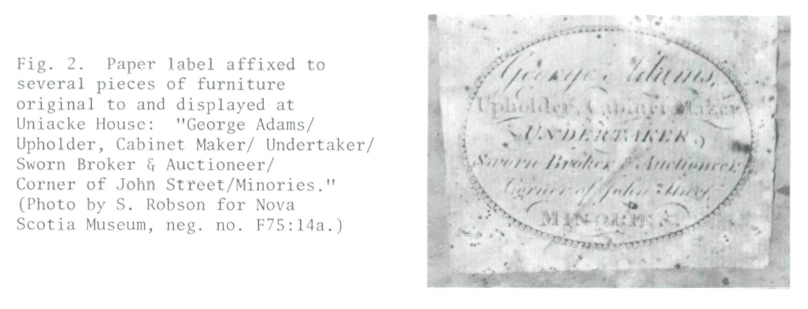 Display large image of Figure 2
Display large image of Figure 28 A file card index of Nova Scotia furniture makers and manufacturers has been established based upon documentary sources such as census material, newspaper advertisements, maps, probate material, and business directories. The amount of information known about each one varies; many entries are based upon a single reference in a city directory while others include transcriptions of numerous newspaper advertisements, census records, and other references. There are about 830 cabinetmakers, chairmakers, carvers, and turners, primarily of the nineteenth century, in the index, which is organized alphabetically within counties.
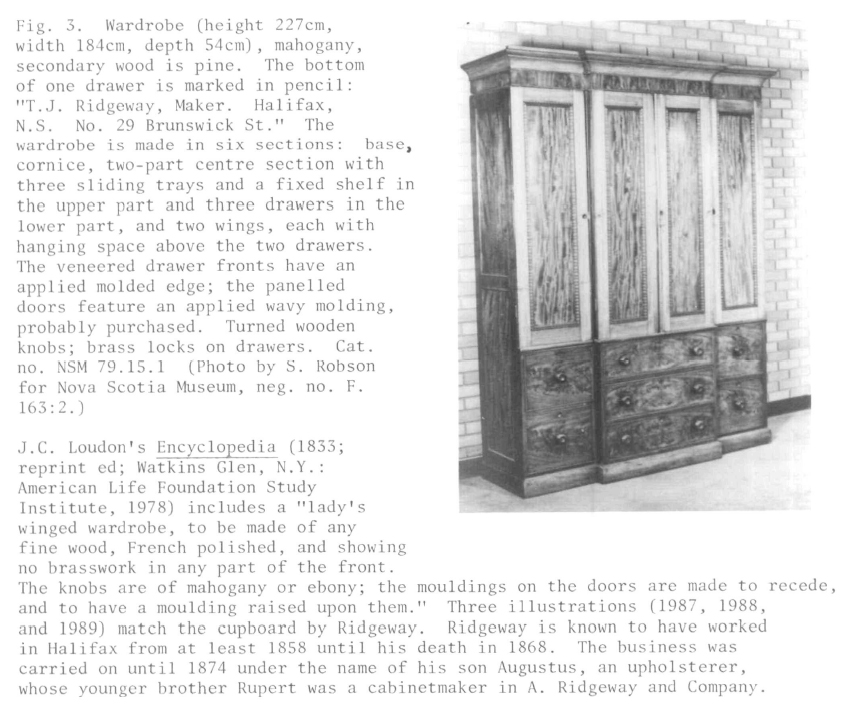 Display large image of Figure 3J.C. Loudon's Encyclopedia (1833; reprint ed; Watkins Glen, N.Y.: American Life Foundation Study Institute, 1978) includes
a "lady's winged wardrobe, to be made of any fine wood, French polished, and showing no brasswork in any part of the front.
The knobs are of mahogany or ebony; the mouldings on the doors are made to recede, and to have a moulding raised upon them."
Three illustrations (1987, 1988, and 1989) match the cupboard by Ridgeway. Ridgeway is known to have worked in Halifax from
at least 1858 until his death in 1868. The business was carried on until 1874 under the name of his son Augustus, an upholsterer,
whose younger brother Rupert was a cabinetmaker in A. Ridgeway and Company.
Display large image of Figure 3J.C. Loudon's Encyclopedia (1833; reprint ed; Watkins Glen, N.Y.: American Life Foundation Study Institute, 1978) includes
a "lady's winged wardrobe, to be made of any fine wood, French polished, and showing no brasswork in any part of the front.
The knobs are of mahogany or ebony; the mouldings on the doors are made to recede, and to have a moulding raised upon them."
Three illustrations (1987, 1988, and 1989) match the cupboard by Ridgeway. Ridgeway is known to have worked in Halifax from
at least 1858 until his death in 1868. The business was carried on until 1874 under the name of his son Augustus, an upholsterer,
whose younger brother Rupert was a cabinetmaker in A. Ridgeway and Company.
9 Extensive studies of furniture makers and their work have been done by local historical societies for two of Nova Scotia's eighteen counties:
- Hector Centre Trust, Exhibits Committee, Nineteenth Century Pictou County Furniture (Pictou, N.S., 1977), published in conjunction with an exhibit shown 1 June - September 1977 researched and built by the Exhibits Committee and with the assistance of the Museums Assistance Programmes, National Museums of Canada;
- Colchester Historical Museum, Colchester Furniture Makers (Truro, N.S., 1979), published in conjunction with an exhibit shown 4 June - 15 October 1979 and with the assistance of the Nova Scotia Museum.
10 The Nova Scotia Museum is eager to assist in similar studies by historical societies or museums in other counties. Such projects are best done with a combination of local and professional knowledge to ensure thorough, useful, and exciting results. Some of the documentary groundwork already exists in the card file index.
11 Nineteenth-century Nova Scotia factory products were singled out for study in a 1979 research project. The documentary evidence gathered referred to fifty establishments (outside the city of Halifax) as "factories" or "manufacturers" between 1852 and 1900. Just what was meant by a "factory" is open for discussion since the word was applied by census enumerators of 1871 to establishments employing only one person and operating only one month per year as well as to year-round operations employing from two to twenty-five men. The museum is collecting factory products and is also interested in machinery although the latter seems to have gone to the scap yard.
12 Individual cabinetmakers provide yet another approach to the study of furniture. The 1975 exhibit "Father and Son, Two Halifax Cabinetmakers" brought together representative pieces of furniture by Thomas C. Holder (1821-94) and Henry A. Holder (1853-1935) as well as tools, documents, and daybooks loaned by the family. The daybooks provided information about materials used, styles and forms produced, and the range of work done by urban cabinetmakers. (See Marie Elwood, "Father and Son: Two Halifax Cabinetmakers," Material History Bulletin, History Division Paper no. 15, National Museum of Man Mercury Series, 1976, pp. 7-15.) Now another cabinetmaking family has emerged for further study. Robert Brander (1821-1909) emigrated from Scotland and eventually established his own business in 1856 in Halifax. During the 1857-61 period, according to the daybook, his work included the following diverse activities: making and repairing furniture, moving furniture, taking down and putting up bedsteads, installing carpets, hanging pictures, moving cutain bands and boards, gilding cornices, repairing and renewing mattresses, installing and repairing locks and hinges. His sons Robert and John later joined the business, John continuing it until the 1930s. A piece attributed to Brander is shown in figure 5.
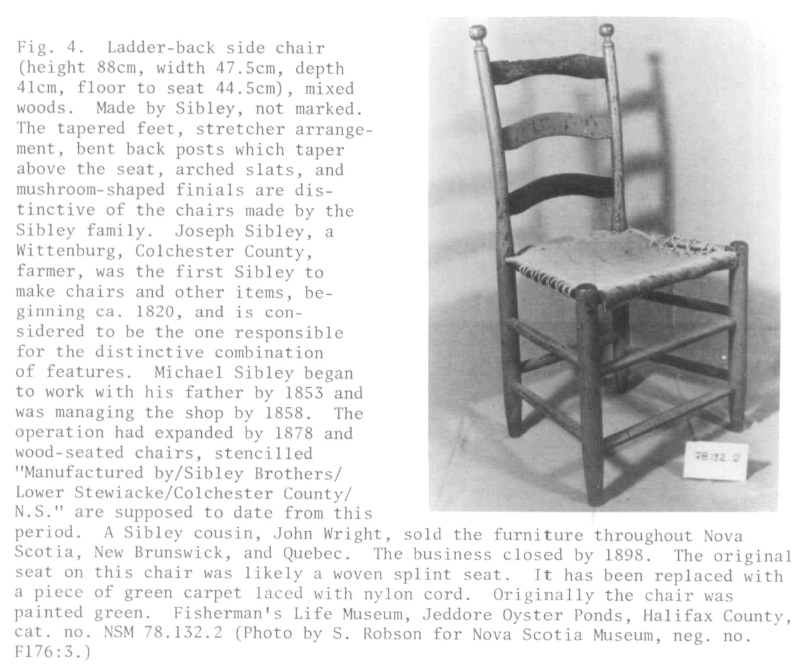 Display large image of Figure 4
Display large image of Figure 4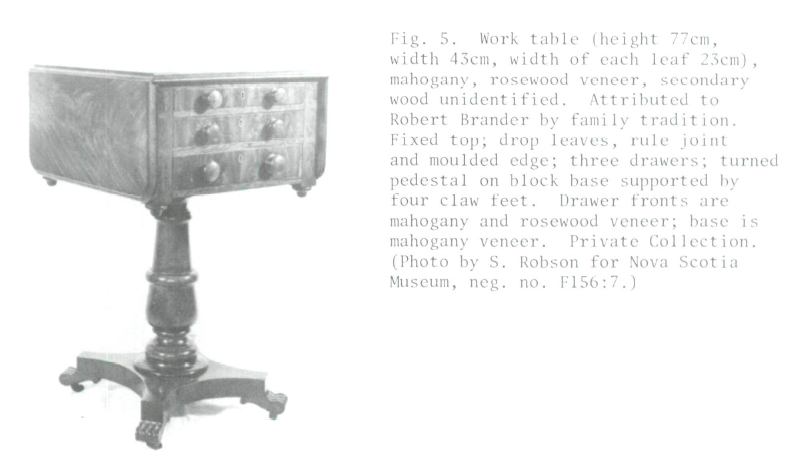 Display large image of Figure 5
Display large image of Figure 513 Miniature pieces have become a group for further consideration. They are sometimes identifiable as apprenticeship pieces by particular makers because they are either marked with the maker's initials and/or they have a family attribution. Forms include chests of drawers and boxes. Little is currently known about the apprenticeship or training of furniture makers.
14 A Brookfield, Colchester County, farmer's estate inventory from 1880 indicated that chairs were the most numerous furniture form in his possession and so it is with the Nova Scotia Museum's collection. In 1976 the museum produced the travelling exhibition "Eighteen Chairs" as a record of the range of chair types and styles in its collections. (See "Eighteen Chairs from the Collection of the Nova Scotia Museum," The Occasional 4, no. 2 (Winter-Spring 1976-77): 44-49.)
15 Recently chairs in the collection have been studied for another purpose — to select examples for reproduction by R.J. Lair, wood turner and chairmaker at Sherbrooke Village, a branch museum of the Nova Scotia Museum. Since February 1980 Lair has been working to establish a shop which will help present Sherbrooke as a representative Nova Scotian community of the 1860-1900 period. During the open season (15 May - 15 October each year), he will demonstrate the skills involved in producing furniture and woodenware using hand tools and foot-powered machinery, adding yet another dimension to our knowledge of Nova Scotia furniture.
